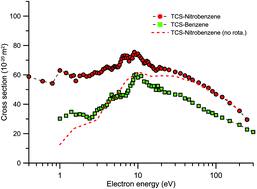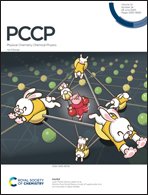Electron scattering cross sections from nitrobenzene in the energy range 0.4–1000 eV: the role of dipole interactions in measurements and calculations†
Abstract
Absolute total electron scattering cross sections (TCS) for nitrobenzene molecules with impact energies from 0.4 to 1000 eV have been measured by means of two different electron-transmission experimental arrangements. For the lower energies (0.4–250 eV) a magnetically confined electron beam system has been used, while for energies above 100 eV a linear beam transmission technique with high angular resolution allowed accurate measurements up to 1000 eV impact energy. In both cases random uncertainties were maintained below 5–8%. Systematic errors arising from the angular and energy resolution limits of each apparatus are analysed in detail and quantified with the help of our theoretical calculations. Differential elastic and integral elastic, excitation and ionisation as well as momentum transfer cross sections have been calculated, for the whole energy range considered here, by using an independent atom model in combination with the screening corrected additivity rule method including interference effects (IAM-SCARI). Due to the significant permanent dipole moment of nitrobenzene, additional differential and integral rotational excitation cross sections have been calculated in the framework of the Born approximation. If we ignore the rotational excitations, our calculated total cross section agrees well with our experimental results for impact energies above 15 eV. Additionally, they overlap at 10 eV with the low energy Schwinger Multichannel method with Pseudo Potentials (SMCPP) calculation available in the literature (L. S. Maioli and M. H. F. Bettega, J. Chem. Phys., 2017, 147, 164305). We find a broad feature in the experimental TCS at around 1.0 eV, which has been related to the formation of the NO2− anion and assigned to the π*(b1) resonance, according to previous mass spectra available in the literature. Other local maxima in the TCSs are found at 4.0 ± 0.2 and 5.0 ± 0.2 eV and are assigned to core excited resonances leading to the formation of the NO2− and O2− anions, respectively. Finally, for energies below 10 eV, differences found between the present measurements, the SMCPP calculation and our previous data for non-polar benzene have revealed the importance of accurately calculating the rotational excitation contribution to the TCS before comparing theoretical and experimental data. This comparison suggests that our dipole-Born calculation for nitrobenzene overestimates the magnitude of the rotational excitation cross sections below 10 eV.

- This article is part of the themed collection: 2020 PCCP HOT Articles


 Please wait while we load your content...
Please wait while we load your content...